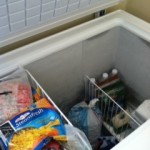
This weekend, I had a real life nightmare…we discovered our freezer had gotten unplugged (not really sure how, but Adam seems to think the broom that was by it, had knocked the plug in out of the socket)…well to say the least, we had a mess on our hands! I know this has happened to others, whether it’s due to a power outage or your freezer not working correctly, but no matter what, it’s never fun! A good portion of the meat in the freezer was partially to completely un-thawed which tested our knowledge of food safety and practice. As I was cleaning the mess, I thought this would be a good topic to discuss on the blog as food safety is often times taken for granted.
The FDA has an excellent food safety website (www.foodsafety.gov) that is devoted to supplying us with the facts and recommendations for proper food safety. It is recommended that your freezer temperature be at or below zero degrees F. If you have thawed or partially thawed food in the freezer, it may be safely refrozen if it still contains ice crystals or is at 40 degrees F or below. Anything between 40-140 degrees is known as the “danger zone” and can result in food borne illness. Now partial thawing and refreezing may affect the quality, but the food is safe to eat. Keeping an appliance thermometer in your freezer will help you determine if the food is safe. You can not rely on the appearance, odor, or taste to determine if the food is safe, you must test the temperature! Another important note is that any items that have came in contact with raw meat juices, must be discarded. This was the case for the bottom layer in my freezer. I was not happy about discarding a good deal of meat, but it’s better to be safe than sorry.
The FDA has an excellent chart to help you work through this issue, check it out at: http://www.foodsafety.gov/keep/charts/frozen_food.html.
I will also be discussing the four main principles of food safety: clean, separate, cook, chill as the temperatures start to rise and picnics and camping become more prevalent…it’s even more important to practice proper food safety.
-Kelsey

